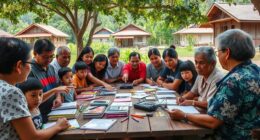There is a popular saying that suggests achieving a goal can be done using various methods.
When it comes to greeting someone in Indigenous Australian languages, the diversity and richness of these languages offer a multitude of ways to express hello.
But before you jump in, it's important to understand the cultural significance behind these greetings and the practical tips for pronunciation.
So, if you've ever wondered about the various ways to say hello in Indigenous Australian languages and the stories behind them, then stick around for an insightful exploration of this fascinating topic.
Key Takeaways
- There are over 250 different Indigenous languages spoken across Australia, each carrying stories, traditions, and connection to the land.
- Many of these languages are endangered and at risk of extinction, making language preservation efforts crucial for safeguarding cultural heritage.
- Aboriginal languages reflect the complexity and richness of Indigenous Australian cultures, and greetings often involve acknowledging the land and ancestors.
- Learning and using greetings in Torres Strait Islander languages shows respect for their cultural heritage and supports language revitalization efforts.
The Diversity of Indigenous Australian Languages
Indigenous Australian languages encompass a rich and diverse tapestry of linguistic traditions, reflecting the vibrant cultural heritage of the continent's First Nations peoples. The linguistic diversity is astounding, with over 250 different Indigenous languages spoken across Australia. Each language is a unique vessel of knowledge, carrying within it the stories, traditions, and connection to the land of its speakers.
However, many of these languages are endangered, facing the risk of extinction due to various historical and contemporary factors such as colonization, forced assimilation, and social marginalization.
Language preservation efforts are crucial in safeguarding this invaluable cultural heritage. Indigenous language revitalization initiatives aim to reclaim, maintain, and strengthen these languages, allowing them to thrive once more within their respective communities. These efforts encompass a range of activities, including language documentation, educational programs, community language revitalization projects, and the incorporation of Indigenous languages into official domains like media and government services.
Greetings in Aboriginal Languages

Exploring the rich tapestry of Indigenous Australian languages, we now turn our attention to the fascinating ways in which greetings are expressed in various Aboriginal languages. The diversity of Aboriginal languages reflects the complexity and richness of Indigenous Australian cultures. Traditional greeting customs in Aboriginal languages often convey deep respect for the land, ancestors, and community.
For instance, in some Aboriginal languages, greetings involve acknowledging the land and the ancestors as a way of showing reverence and gratitude. It's important to recognize that there are hundreds of distinct Aboriginal languages, each with its own unique ways of greeting. Understanding and respecting the diversity of Aboriginal language greetings is essential for meaningful cross-cultural communication.
In mastering the art of greeting in Aboriginal languages, it's crucial to appreciate the traditional customs and the significance they hold within Indigenous communities. By delving into the nuances of these greetings, one can gain a deeper understanding of the cultural values and customs embedded within the fabric of Indigenous Australian societies.
Embracing the complexity of traditional greeting customs in Aboriginal languages fosters mutual respect and appreciation for the diverse linguistic and cultural heritage of Indigenous Australians.
Saying Hello in Torres Strait Islander Languages
When engaging with the Torres Strait Islander communities, you can start by learning how to say 'hello' in their languages to show respect and appreciation for their cultural heritage. Understanding and using traditional greetings is a meaningful way to honor Torres Strait Islander customs and contribute to language revitalization efforts.
Here are some common ways to say 'hello' in Torres Strait Islander languages:
- Kamal: This is the traditional greeting in the Meriam Mir language spoken in the eastern Torres Strait.
- Aay: In the Kalaw Lagaw Ya language of the central and western Torres Strait, this is a friendly way to say 'hello'.
- Ses: Another greeting in the Kalaw Lagaw Ya language, often used to say 'hello' or 'hi'.
- Wada: In the Torres Strait Creole, which is a language widely used across the region, 'wada' is a casual way to greet someone.
Learning and using these greetings not only shows your respect for Torres Strait Islander customs but also supports the ongoing efforts to preserve and celebrate their languages.
Cultural Significance of Greetings

To fully appreciate the cultural significance of greetings in Torres Strait Islander communities, it's important to recognize the value and respect embedded within the traditional ways of saying 'hello' in their languages. Traditional customs play a vital role in the social fabric of Torres Strait Islander communities, and greetings are a profound manifestation of this.
Greetings aren't merely a formality but a way of acknowledging the interconnectedness and kinship ties that underpin their societies. The act of greeting one another is a demonstration of respect for the individual and their community, reflecting the significance placed on interpersonal relationships and communal harmony.
Furthermore, the importance of language preservation is evident in the greetings used by Torres Strait Islanders. The traditional languages contain unique linguistic nuances that capture the essence of their cultural heritage, and by preserving these languages through greetings, they safeguard their identity and traditions for future generations.
Understanding the cultural significance of greetings in Torres Strait Islander communities provides insight into the profound depth of their traditions and the respect they hold for their language and customs.
Practical Tips for Pronunciation

For mastering the pronunciation of traditional greetings in Torres Strait Islander languages, paying attention to subtle linguistic nuances and practicing with native speakers can greatly enhance your proficiency. When it comes to language learning, pronunciation is essential for effective communication. Here are some practical pronunciation tips to help you improve your skills:
- Listen Carefully: Pay close attention to the sounds of the language as spoken by native speakers. Listen to recordings or engage in conversations to familiarize yourself with the correct pronunciation.
- Practice Regularly: Consistent practice is key to improving your pronunciation. Repeat the words and phrases frequently, focusing on the nuances of each sound.
- Seek Feedback: Don't hesitate to seek feedback from native speakers or language instructors. They can provide valuable insights and correct any mispronunciations.
- Mimic Mouth Movements: Observe the mouth movements of native speakers as they pronounce words. Mimicking these movements can help you produce the sounds more accurately.
Frequently Asked Questions
Are There Any Specific Gestures or Body Language That Are Commonly Used When Greeting Someone in Indigenous Australian Cultures?
When greeting someone in Indigenous Australian cultures, common body language and traditional greetings play a significant role.
Handshakes, nods, and physical contact are often used to convey warmth and respect.
Eye contact is important, as it shows attentiveness and sincerity.
Traditional greetings may also involve sharing a story or asking about one's well-being.
These gestures and body language are deeply rooted in the culture and are essential for building rapport and showing mutual respect.
Are There Any Taboos or Cultural Norms to Be Aware of When Greeting Someone in Indigenous Australian Cultures?
When greeting someone in Indigenous Australian cultures, it's important to be aware of taboos and cultural norms. Certain gestures and body language may be inappropriate, so it's best to approach with respect and openness.
Understanding the significance of greetings in Indigenous Australian communities is crucial to avoid unintentional offense. Take the time to learn about the specific customs and traditions of the particular group you're interacting with, as these can vary widely across different Indigenous Australian cultures.
How Do Indigenous Australian People Typically Respond to a Greeting? Is There an Expected or Traditional Response?
When greeting Indigenous Australian people, typical responses may include a warm smile, respectful nod, or a handshake. These traditional responses are often accompanied by nonverbal communication, such as maintaining eye contact and using a calm voice.
It's important to be mindful of cultural norms and show genuine respect. Understanding and honoring these traditions fosters positive interactions and demonstrates your appreciation for Indigenous Australian culture.
Are There Any Specific Times or Occasions When Greetings Are Particularly Important in Indigenous Australian Cultures?
Specific occasions when greetings are particularly important in Indigenous Australian cultures include:
- Traditional ceremonies
- Social gatherings
- Elders' meetings
These events hold significant cultural and spiritual importance, making the exchange of greetings a vital part of the community's traditions.
It's customary to show respect and acknowledgment during these occasions by offering and responding to greetings in a manner that reflects the values and customs of the Indigenous Australian culture.
Are There Any Differences in the Way Greetings Are Exchanged Between Different Indigenous Australian Communities or Regions?
In Indigenous Australian cultures, diverse greetings customs exist, with regional variations in greetings reflecting the rich diversity of traditions and languages.
Greetings can differ between different Indigenous Australian communities or regions, showcasing the unique cultural practices and linguistic diversity present across the continent.
It's important to recognize and respect these variations when engaging with Indigenous Australian communities, as it demonstrates an understanding and appreciation of their rich cultural heritage.
Conclusion
So, next time you meet someone from an Indigenous Australian community, don't be afraid to greet them in their own language.
It's like opening a door to a whole new world of culture and connection.
Just remember to approach it with respect and an open heart.
Who knows, your 'hello' might just be the start of a beautiful conversation.
Keep the spirit of diversity and inclusivity alive in your greetings!
Mary is a passionate writer who brings creativity and a fresh perspective to our team. Her words have the power to captivate and inspire, making her an essential contributor to our content. Mary’s commitment to storytelling and dedication to promoting Indigenous culture ensures that her work touches the hearts of our readers. We’re fortunate to have her as part of our team.










